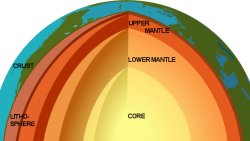
March Editorial
A stiff new layer in the mantle - a corset for Mother Earth?

March Editorial
A stiff new layer in the mantle - a corset for Mother Earth?
|
|
The inside of the Earth is structured in layers. There is the crust, which is up to 50 miles deep, then the mantle and the planet's iron core at the centre. However, these main layers are further subdivided, for example into the lower and upper mantle. This subdivision is done largely according to the minerals which are present in each of those layers. |
|
|
Nor is the content of each layer stable. The Earth's crust is continually recycled back into the mantle. This recycling happens at the edge of tectonic plates in areas known as subduction zones. Subduction zones are where earthquakes and volcanism are at their highest. They exist where the lithosphere (which is the crust and part of the upper mantle) of one plate converges with that of another plate. Where the tectonic plates collide one plate slides under the other, and the lower plate sinks into the mantle. Stable subduction zones involve the oceanic lithosphere of one plate sliding beneath the continental lithosphere or oceanic lithosphere of another plate due to the higher density of the oceanic lithosphere. That is, the subducted lithosphere is always oceanic while the overriding lithosphere may or may not be oceanic. The descending slab sinks slowly to the lower mantle. The rate of subduction is about 2-8 cm per year, so it takes approximately 300 million years for a slab to descend into the lower mantle. A number of earlier studies have used seismic images to show that this descent is not always smooth. Some slabs get stuck in the shallow lower mantle and stagnate. The question is, why does the descent of these slabs stagnate? Mineral structures found in the lower mantle include silicate perovskite (Mg,Fe)SiO3 (also known as bridgmanite - see Dec 2014 editorial) and calcium silicate (CaSiO3 when arranged in a perovskite structure. Silicate perovskite together with Ferropericlase (magnesium/iron oxide (Mg,Fe)O) are thought to form the main mineral phase of the lower mantle. Since those minerals do not show any structural transitions at these depths there should be no reason for slab stagnation. New studies (ref) from the University of Utah may have found the answer to this puzzle. The scientists used synchrotron radial X-ray diffraction to measure the crystal deformation of ferropericlase at pressures of up to 96 GPa. They identified the probable presence of a 'super viscous' layer in the lower mantle. They did this with gem-quality diamond anvils which squeezed ferropericlase to pressures which exist in the Earth's lower mantle. It has been generally believed that an average temperature at the top of the lower boundary of the mantle is 2800 degrees Fahrenheit (1537oC) and the pressure there is 235,000 times the atmospheric pressure on Earth's surface. From there the authors extrapolated to get the temperature and pressure at a depth of 930 miles. This is the depth where the descent of the slabs is thought to stagnate. With those parameters, the group then studied how lower mantle minerals behave in the laboratory. As the lead author, of this research, Lowell Miyagi, explains: "To do that, you take two gem quality diamonds and trap a sample between the tips...The sample is about the diameter of a human hair. Because the diamond tips are so small, you generate very high pressure just by turning the screws on the press by hand with Allen wrenches." Crystals of ferropericlase with 10% and 20% iron content were subjected to pressures which mimicked the conditions at different depths of the lower mantle. This resulted in a significant discovery. At pressures from 20 to 65 GPa the strength of ferropericlase increases by a factor of three. That is, in conditions mimicking those 930 miles under the Earth’s surface, the liquid rock becomes about 300 times more viscous than it is at a depth of 410 miles. Modeling based on the experimental data shows that the viscosity in the region surrounding the subducting slabs could increase by 2.3 orders of magnitude throughout the top 900 km of the lower mantle. "The result was exciting," Miyagi says. "This viscosity increase is likely to cause subducting slabs to get stuck - at least temporarily - at about 930 miles underground. In fact, previous seismic images show that many slabs appear to 'pool' around 930 miles, including under Indonesia and South America's Pacific coast. This observation has puzzled seismologists for quite some time, but in the last year, there is new consensus from seismologists that most slabs pool." Interestingly, the laboratory simulation also showed that just below the 930 miles underground the mantle once again becomes less viscous and the slabs start sinking freely once again. Journal Reference: | |
| _______________________________ | ||||
| Home | | | Shopping | | | Database |
© Biscuit Software 2004-2015
All rights reserved